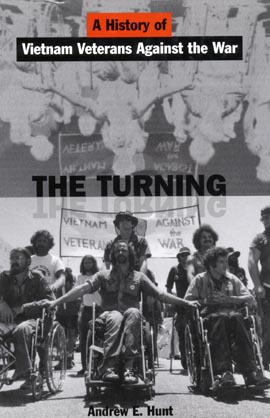 |
Stories of VVAWBy Kurt Hilgendorf (Reviewer)
The Turning: A History of Vietnam Veterans Against the War
Within the past several years, several books documenting the history of VVAW have been published. Of these, Andrew Hunt's "The Turning" may be one of the most accessible. Over the course of a long afternoon, a reader can cover engaging accounts of VVAW's founding and patchwork early development, the preparation and execution of Operation RAW, the mixed results of the Winter Soldier investigation, VVAW's dramatic growth after Operation Dewey Canyon III, the 1972 Republican National Convention, the trial of the Gainesville Eight, and the group's decline after the "official end" of American involvement. Hunt's extensive interviewing of VVAW members, and notably his inclusion of interviews with people outside national leadership, provides rich and personal accounts of crucial events and campaigns. This book is a good read for both those new to the stories of VVAW and longtime members and supporters. Hunt's analysis of VVAW's major triumphs, internal struggles, and process of development is perhaps the strongest part of "The Turning." He handles events like the 1968 Democratic National Convention and its impact on VVAW with stark honesty: The veterans left Chicago feeling depressed and powerless. Several dedicated VVAW activists simply disappeared following the convention and never resurfaced. McCarthy's defeat in Chicago killed the hopes of veterans and dashed their faith in electoral politics. In the process he lays the groundwork for the radicalization process VVAW would undergo several years later. While speaking of Operation Dewey Canyon III, Hunt writes: The evolution of Dewey Canyon III paralleled that of VVAW. Veterans initially participated in conventional forms of resistance. However, disillusionment set in quickly, and most of the VVAWers consciously chose to adopt more confrontational tactics. Such overt defiance thrust VVAW into the national spotlight, as the image of men hurling medals was etched into the national conscience.
In the process of his analysis, Hunt richly quotes VVAW members, letting the voices of the organization come to the forefront through detailed firsthand accounts and analysis. Hunt is also effective at uncovering and addressing oft-overlooked parts of VVAW's history. Early in "The Turning," Hunt writes of Jeff Sharlet's contribution of the newspaper Vietnam GI and the impact of his untimely death from cancer. Later in the book, Hunt addresses VVAW's efforts to become a broad-based multi-issue organization, especially with regard to addressing the rampant racism and sexism both in American society and within the organization. He writes of the Lifeline to Cairo and VVAW's role in supporting the African American community in the small Illinois river town; he also describes the struggle to recruit veterans of color to the organization. Hunt's discussion of women in VVAW is notably engaging. Rather than simply chastising the group for its early rejection of women members, he outlines VVAW's progression toward a more egalitarian organizational structure: There were no pat answers to the gender conflicts in VVAW, but the status of women would continue to improve in the organization. Combating sexism later became a significant objective in VVAW's statement of purpose. Despite Hunt's engaging and in-depth history, there are glaring omissions. Hunt essentially ends the organization's history in the mid-1970s. A detailed description of the impact of government surveillance on the organization and primary-source accounts of the Gainesville Eight trial are welcome inclusions. Interestingly, he writes about VVAW's "cyclical" growth after American military interventions in Central America and Gulf War I, something the organization has experienced again during the Bush II regime. However, Hunt says relatively little on two of VVAW's most important legacies: the creation of post-Vietnam syndrome rap groups and the Agent Orange lawsuits. While he covers the history of rap groups, Hunt avoids an in-depth discussion on this groundbreaking research or its subsequent impact on the study and treatment of post-traumatic stress disorder. As for Agent Orange, Hunt makes only passing references to the lawsuit and says virtually nothing about the organization's subsequent rejuvenation. Hunt also mishandles the history of the creation of VVAW/AI as a bogus ultraleft "hologram" of VVAW. Nowhere does he mention that group's creation in order to directly siphon off support and usurp the history of the legitimate organization. And for an author who had consistently included the voices of a diverse group of the organization's members, Hunt in the last chapter chooses only to focus on leadership, thereby mitigating the contributions of VVAW rank-and-file. Despite these criticisms of "The Turning," Hunt's book makes a valuable contribution to the literature on VVAW through its accessible style and thoroughness in detail and analysis. I would especially recommend it to students studying Vietnam vets or people who have just become acquainted with VVAW. In conjunction with Richard Stacewicz's "Winter Soldiers" (unfortunately out of print), Hunt's book provides an excellent look into the vitally important history and legacy of Vietnam Veterans Against the War.
Kurt Hilgendorf is a member of the Champaign-Urbana Chapter of VVAW and is currently "on sabbatical" at Illinois State University studying to become a high school teacher.
|


